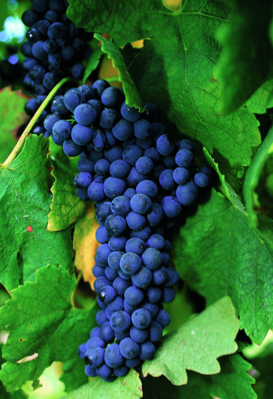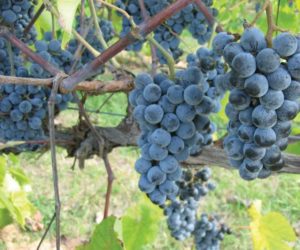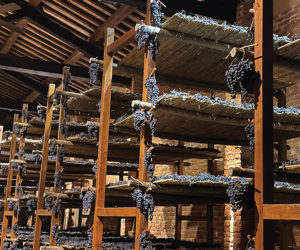
Several Rhône grapes, such as Mourvèdre, Grenache, and Carignan, have been planted in California for decades and so acreage actually exists. Others, such as Syrah, Viognier, and Rousanne, are relatively recent arrivals, and much that has been planted has been done at wineries’ request. Still, it is possible to find these grapes and they are certainly worth searching out.
Syrah and Carignan make an interesting pair to consider from a production point of view. They occupy almost opposite positions on the esteem spectrum. Syrah produces some of the most highly regarded red wines in the world. Carignan has the dubious distinction of being limited to a maximum of 30 percent of the most basic Côtes du Rhône wines. And yet they both yield full, dark wines that can be made successfully on a small scale.
Both varieties are found throughout California, Carignan because it has been planted since the last century as an all-around red blender and Syrah because it shows such promise that everyone wants to try it. The best-quality fruit of either variety generally can be found in the coastal and foothill regions of the state. Considerable acreage is also grown in the Central Valley. Syrah can be grown successfully in the coolest regions, whereas Carignan needs the slightly warmer climates. Other states where Rhône varieties are grown include Washington (Syrah and Grenache), Colorado (Syrah and Viognier), Virginia (Viognier, Marsanne, Mourvedre, and Grenache).
Wine quality is always best when vines are cropped conservatively. But because most Syrah acreage in California is young, yields are higher than for the typically older Carignan vineyards — say four to six tons an acre vs. three to four respectively. Carignan’s poor reputation in France stems partly from the fact that when it is overcropped — which is easy to do with Carignan because it has a natural tendency to set a large crop — wine quality is very poor. The advantage in California is that most of the Carignan vineyards are mature, if not downright old, so naturally yield less.
Choosing Grapes
Home winemakers often have little input into viticultural practices, but there are some things to watch out for. Mildew and bunch rot can be problems in Carignan during wet years. Clusters are typically large and tight and can deteriorate if crop level is high or canopy is dense. Syrah tends to have a smaller, looser cluster and is more tolerant of wet weather. In fact drought can be a bigger problem. Syrah typically loses leaves in the area around the clusters as ripeness approaches, and shriveling can creep up suddenly in dry years.
Both varieties should be picked fully ripe, and this is critical with Carignan. As Carignan approaches ripeness, when field sampling first indicates a sugar level of, say, 23.5° Brix, pH will still be under 3.3. If the fruit is picked at this point, sugar level in the tank may actually measure less than 23° Brix and acidity will be high enough to make the wine taste lean and hard. Most of the Rhône varieties make low-acid (less than six grams per liter) wines when they are fully ripe, but that’s okay (really). It’s best to wait until pH rises above 3.4, at which point sugar is generally in the 24.5° Brix range. Not only is texture and mouthfeel better at this point, but flavors are more complex and richer than they would be at lower ripeness levels.
Syrah’s tendency to show water stress as it ripens is reflected in the chemistry of field samples. The pH may be above 3.5 even with sub-23° Brix sugar levels, but the fruit will still retain a tart taste. It is very important to pick Syrah by taste — to watch for the disappearance of tartness — and to consider Brix, titratable acidity (TA), and pH secondarily. Don’t worry too much if your 24.5° Brix must has a pH of 3.7 and a TA under six grams per liter. Carignan, on the other hand, can be picked more by the numbers: pH higher than 3.4 and TA less than seven grams per liter, with sugar in the 23.5° to 24.5° Brix range.
If you receive uncrushed fruit, take the time to sort it before beginning to make wine. Discard rotten, mildewed, underripe, or poorly colored fruit. As a home winemaker you are dealing with small quantities of fruit, so it won’t take long. You don’t have a bottom line to worry about, and this may be your first opportunity to influence the quality of your wine. Yes, the grapes still cost money, but making a little less wine that is substantially improved doesn’t cost extra. Besides, you’re making this for your own enjoyment; make it the best you can.
Both Syrah and Carignan respond well to fermentations with uncrushed fruit. Syrah, especially, undergoes a dramatic change in aroma when whole berries or whole clusters are included in the fermenter. If a crushed and destemmed fermentation yields smoky/meaty/earthy aromas, whole fruit will bring out sweeter, more berry-like aromas. Given that ripe or brown stems are seldom seen in harvested fruit in California, the best practice is to destem without crushing. If this isn’t possible, and if the lot is small enough, crushing by foot and fishing the stems out later also works.
Yeast Selection
There are many interesting yeast strains available to the winemaker these days. Each has been selected for some special property it brings to a fermentation, whether it is temperature tolerance, enzyme activity, or ability to completely ferment high-sugar musts. The newer strains cost more (more than double the price of standards such as Montrachet and UCD595), but some have yielded impressive results. The strain Brunello has produced Mourvèdre with better mouthfeel than the UCD595. RC212 (a Burgundian strain) has produced Syrah with a higher floral character than Brunello. QA23 produces Viognier with greater exotic perfume than the Epernay 2.
Wild or uninoculated fermentations are favored by many winemakers for producing wines with more complexity than pure-strain fermentations. The decision to “go natural,” however, should be made only when conditions are right. If fruit is not free of rot and the winery is not clean, the longer lag phase of a wild fermentation can allow spoilage organisms to gain a foothold before Saccharomyces takes off. Off-flavors, high volatile acidity, and stuck fermentations can result from fruit in poor condition, even when you use a cultured strain of yeast, so be vigilant!
Fine-Tuning
Syrah and Carignan can give soft, fruity, early drinking wines if the fermentation is cool and short, but let’s assume that’s not what you’re after. Extract, color, and mouthfeel improve when the fermentation is warm (85° to 90° F), but you may have to work at this. Put the fermenter in the sun or use heating pads. Punch down the cap as many times a day as is practical, at least twice at day. Both varieties will also benefit from long macerations; but it’s important to protect the wine from spoilage as CO2 production falls off. If you can’t blanket the fermenter with CO2, don’t attempt an extended maceration, meaning anything longer than it takes to reach dryness.
This raises another time-element issue. The smaller the wine lot, the shorter the whole vinification process should be. You can make delicious wine from very small quantities of fruit if you shorten everything up: rack soon, don’t try to introduce oak flavor just because Chateau Woodstone Hills Creek does it, be paranoid about oxidation, and bottle early.
Neither Carignan nor Syrah needs much new wood, but they do benefit from barrel aging. If you are making less than 10 gallons, don’t worry about barrel aging. If you’re making one barrel (60 gallons) of wine, nothing newer than 2 years old should be used and a neutral barrel, if it’s in good condition, works just fine. The importance of barrel conditioning in small-scale winemaking can’t be over-emphasized. Better to keep wine in glass or stainless steel than in some old French oak barrel that has become tanky or swampy from being stored for years with bad water in it. Many wineries sell 4- to 6-year-old barrels for $50 or less, so replace old cooperage as often as you need to.
If you simply must have oak character in the wine, go easy. Use no more than a small handful of medium-toast chips (not shavings) per five-gallon carboy. The lovely smoky/berry aroma of these wines is quickly buried under a lot of wood. Remember that in the most traditional wineries of the Rhône Valley, the wines never see new wood.
If you make more than one variety of wine, don’t be afraid to blend into either Carignan or Syrah. If your Syrah is dense or heavy, lighter reds or even aromatic whites can really punch up the nose. If your Carignan is simple or coarse, a small amount of something complex will add interest.
As a home winemaker you have this advantage over commercial wineries: You don’t have to conform to labeling requirements or fit into a market segment. Satisfying your own pleasure is your only rule. If a blend of 60 percent Syrah, 35 percent Zinfandel, and 5 percent Chenin Blanc works best, then that’s what you should make.




